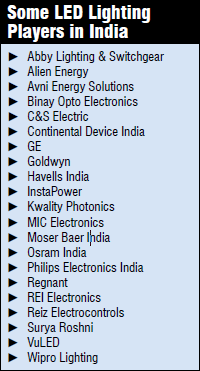“In India, the industry is limited to few people who keep on switching from one company to another. There is not much of value addition done year by year to this industry. The only way to do that is by infusing new blood into this industry. Without new ideas and understanding of the vastness of this industry, things will never improve,” says Mr Sood.
“Lighting can influence the whole working culture—offices, homes, hospitals, airports and industrial environments all need different kinds of lighting.The industry needs people from engineering background, architectural background (interior designers) and even physiologists because lighting has so much of influence on the human mind itself,” he adds.
Where to study?
Jadavpur University offers a purely technology-oriented course. It offers M.Tech in illumination technology, which is a two-year full-time course. Also, there are some universities which have adopted illumination engineering as one of the elective subjects at the BE level. These include Manipal, Mumbai and Pune universities apart from Jadavpur University.
“As the industry needs knowledge of marketing too, on the lines of sector specific MBA courses, we conceptualised an MBA course in lighting technology and energy management. This course was launched in 2007 at MIT Group, Pune as a two-year full-time postgraduate programme. The success of this course can be gauged from the fact that till the last fourth batch, there have been more than 100 per cent placements; some candidates have even received more than three-four placement offers including overseas offers,” informs Dr Barjatia.
The course structure of this programme is lighting technology (40 per cent), marketing management (40 per cent) and energy management (20 per cent). Lighting/energy management subjects taught are introduction to lighting technology, lighting and its measurement, light sources, luminaires, lighting applications, biological effects of light, lighting design, lighting management and energy management.
“With LED coming in a big way, everybody is feeling the need for LED lighting professionals. As a result, new courses are coming up. Some online courses are also available,” adds Dr Barjatia.
At the global level, the industry is proactive and the community responds to the actions of the industry. The Lighting Research Center (LRC) in New York is one example. Part of Rensselaer Polytechnic Institute, it is a leading university-based research centre devoted to lighting. It also offers graduate education in lighting, including one- and two-year master’s programmes and a Ph.D. programme. The Solid-State Lighting Program at LRC conducts necessary research and educational programmes to enhance LED lighting technology, overcome barriers to effective use, and help it to gain acceptance for general illumination purposes.
Each LED is designed to teach industry professionals how to incorporate LEDs into lighting applications. It also includes updated technical content based on the latest industry developments. Through hands-on workshops and classroom sessions, participants learn the basics of LED technology while building an understanding of LED system integration issues involving the electrical, optical and thermal characteristics of LEDs. Participants also learn how to measure and evaluate LEDs and LED systems, and have the opportunity to compare LED technologies from a variety of manufacturers. The programme culminates with the participants designing, building and evaluating their own LED fixtures.

Different roles available
LED lighting is challenging to design as it requires complex driver and control electronics. As an LED lighting designer, one needs to achieve a practical balance between various factors including thermal management, efficiency, dimming, light and colour output, power factor correction (PFC), and safety.
Fortunately, IC manufacturers are responding to new LED device technologies with LED driver solutions that provide the key capabilities.Engineers can find suitable driver ICs optimised for LED lighting applications and tuned to work with specific classes of LEDs while addressing a range of specialised requirements. Available ICs offer switched-mode solutions ranging from charge pumps to single-ended primary-inductor converters, thermal monitoring features, capabilities to help engineers meet PFC standards, and dimming control options available through a simple pulse-width-modulation control pin, among others.
If an LED luminary is made in a well designed way, it can give 50,000 hours of life. On the other hand, LED drivers are available with a life expectancy of only 25,000 hours. Thus enhancing the life expectancy of LED drivers is one area you may be expected to focus on as an R&D professional.
Highly integrated ICs for lighting control and driver electronics bring power management to lighting applications.As a control and driver IC designer, you will be aiming at integration and finding new ways to reduce the form factor. Providing extensive support tooling is also important to allow for the fastest and simplest design. NXP Semiconductors, Infineon, Texas Instruments and Recom are some LED driver solution providers.






